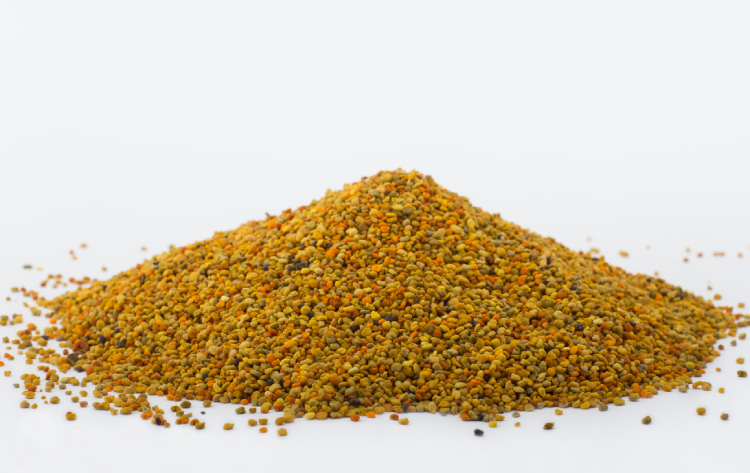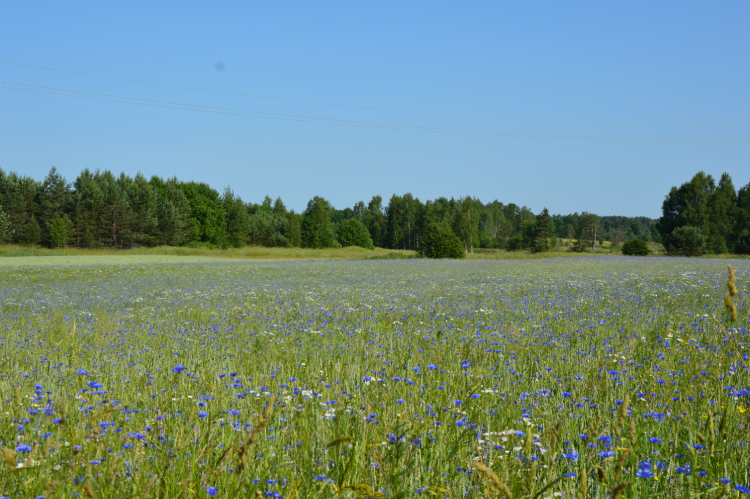Although we tend to think that bees only collect nectar, a medium-sized colony will also collect around 10kg of pollen per season. Pollen is an essential part of the bee diet that provides a variety of nutrients, including protein, carbohydrates, lipids, vitamins, and minerals. In one journey, a bee can carry almost half of its weight in pollen in the pollen basket. Generally, bees will collect from only one type of flower per journey. This is the nature’s way of ensuring that all flowers are pollinated. As a result, a bee that is visiting a blackberry shrub will stay there until there are no more blackberry flowers left unpollinated, and only then will it move on to another plant.

How do bees collect pollen? During flight, a bee’s body charges with a positive static charge. Since the body of the bee is extremely hairy, plant pollen with a negative static charge will stick to these hairs. The bee moistens the hairs on its front legs and ‘washes’ the pollen down to the back legs in order to avoid transferring it to the next flower. These rigid hairs known as corbiculae, or pollen baskets, collect and store the resulting sticky pollen mass. When the pollen baskets are full, the bee returns to the beehive. Although it may look that the pollen on the bee’s legs is unstable and not secure, experimental research has demonstrated that pollen is transported very responsibly. The force required to remove this pollen was about 20 times stronger than what a bee normally experiences when flying.
Bees collect pollen from a variety of plants, which they select specifically for their high nutritional value. Pollen is a major source of nutrients for bees that provides protein, fat, vitamins, and micronutrients such as calcium, magnesium, iron, and zinc. Bee pollen is primarily used as a dietary supplement for humans and animals and works as a natural source of biological vitamins and proteins. Pollen is extremely nutritious. It contains almost all the nutrients that are required for the human body.
The most important component of bee pollen is complete protein, which makes up around 26% to 40% of the ingredients. Pollen contains 5 to 7 times more amino acids than beef and eggs. In addition to that, it contains nucleic acids and nucleoproteins, as well as around 20% of vegetable fats. Pollen has vitamins D, Bj, B2, B5, B6, PP, E, C, biotin, and folic acid. It is rich in potassium – 400 mg/100 g of pollen. There is substantial amount of phosphorus and magnesium, as well as iron, zinc, and cobalt. The key fatty acids in pollen include alpha-linolenic acid (omega-3 polyunsaturated fatty acids), linoleic acid (polyunsaturated omega-6 fatty acids), oleic acid (monounsaturated), and palmitic acid (saturated). Pollen contains lipids, phytocompounds (carotenoids, phenols, as well as flavonoids and phytosterols in their category), active enzymes, coenzymes, hormones, and antioxidant enzymes.
Pollen contains pollen granules from a variety of plants, which vary by region and season. Fresh pollen spoils rather quickly. As a result, it is dried or frozen to preserve it and its nutritional value. Since there are no freezers in beehives, bees have created their own fermentation system, which makes the phytocompounds in the pollen more bioavailable and allows it to be stored in the beehive at its typical temperature of around 35°C for over a year. This form of pollen is known as bee bread.
Pollen is a unique and natural product. It is a complex combination of physiologically active substances. There is no food in nature that matches the composition in all its components that are necessary for the normal development and function of the body. Bee pollen can help compensate for vitamin and mineral deficiencies that modern people tend to experience due to the insufficient nutritional value from their food choices. Pollen is a great source of enzymes and offers more antioxidants than any fruit or vegetable.

Lithuanian pollen is distinctive for its wide range of colours and exceptional fragrance and flavour that are typical of this region only. The flavour and colour intensity varies depending on when the pollen is collected: from a sweet and mild taste in spring to a somewhat bitter flavour in August; from a light colour to a darker one at the end of the season. The diameter of the granules ranges from 1.5 mm to 4 mm, and the wide range of colours varies from light yellow and green to purple, dark brown, and black.
Our pollen is distinctive due to the flowers that are only typical to the northern latitudes and can reach as many as 70 varieties in a season. These latitudes have flowers that cannot be found in the pollen from other regions. As a result, our pollen’s botanical composition is known to be richer and to contain more active ingredients.
Our pollen is not chemically contaminated with heavy metals, pesticides, and other contaminants. It meets the highest requirements for raw materials for pharmaceutical products and dietary supplements. Research has shown that pollen collected from soil that has been generously fertilised with nitrogen contains neither nitrites nor nitrates. These results indicate that pollen undergoes complex biochemical processes that inactivate toxic plant compounds. We should take advantage of this property of pollen and use it as an antioxidant for nitrates in food and water.
Pollen use in food and medicine is relatively recent. People only learned about this product in the late 1960s, albeit Eastern Europeans and Americans have been collecting pollen since the end of the World War II. These days, pollen is a highly desired product for its composition, occupying an important place next to the other bee products. The many healing properties of pollen are largely determined by the hundreds of phytocompounds present therein. Pollen is used in food and medicine, as well as in cosmetics and veterinary medicine. Pollen can be consumed on its own with water or juice or mixed in with honey, added to cocktails, yoghurts, fruit and vegetable salads. It all depends on your improvisational skills with flavours. Children should be introduced to a small granule first and, provided that they feel well, the amount should be gradually increased. It is not recommended for adolescents during puberty due to the pollen’s potent effect as a biostimulator.
Pollen is not a medicine, but a natural dietary supplement.
One tablespoon of bee pollen contains:
- 16 calories
- 0.24 grams of fat
- 1.2 grams of protein
- 2.18 grams of carbohydrates
- 250 types of nutrients, including vitamins and flavonoids.
Recommended dose:
- For adults: 20-40 g or 3-5 tablespoons per day
- For children: 15 g or 1-2 tablespoons per day
Please consult your physician before taking any dietary supplements. If you are allergic to bee or wasp stings, you should avoid bee pollen. Stop taking this supplement immediately if you experience:
- itching
- swelling
- dizziness
- difficulty to breathe
Biologically active pollen ingredients
| Biological activity | Active ingredients |
|---|---|
| Anti-inflammatory | Lycopene (carotenoid) and phytosterols |
| Antioxidant | Carotenoids and phenols |
| Antibacterial, anticarcinogenic and antiviral | Flavonoids, including herbacetin, isorhamnetin, kaempferol, luteolin, myricetin, quercetin, rutin and tricetin |
| Overall impact | Lutein and zeaxanthin (carotenoids), nutrients, and phytosterolsmedžiagos ir fitosteroliai" |
Effects of active pollen ingredients on human health:
- Protein: Pollen has a complete and balanced spectrum of amino acids.
- Vitamins: Pollen contains all known vitamins and is particularly rich in nicotinic acid (vitamin B3), pantothenic acid (vitamin B5), and riboflavin (vitamin B2).
- Minerals: Pollen contains all necessary micronutrients.
- Lipids: Pollen is a healthy source of dietary fat. The main fatty acids in pollen include alpha-linolenic acid (omega-3 polyunsaturated fatty acids), linoleic acid (polyunsaturated omega-6 fatty acids), oleic acid (monounsaturated), and palmitic acid (saturated).
- Phytocompounds: Phytocompounds make up the most significant nutritional aspect of pollen. Although the specific profiles of phytocompounds vary from plant to plant, pollen is rich in carotenoids, phenols, as well as flavonoids and phytosterols of their category.
- Active enzymes: Fresh pollen contains many active enzymes, coenzymes, and hormones. Antioxidant enzymes, such as catalase, help fight or prevent damage caused by free radicals.
Advantages of key quality parameters of pollen
| No | Name of parameter | Unit of measurement | Most common in the market | Requirement of our company‘s standart |
|---|---|---|---|---|
| 1. | Protein | % | < 10 ÷ 19 | Min 23 |
| 2. | Ashes | % | Max 2,8 | |
| 3. | Total fat | g/100g | Min 11 | |
| 4. | Calorific value | kJ/kcal/100g | 1794/425 | |
| 5. | Total sugar | g/100g | 33,5 | |
| 6. | Carbohydrates, calculated | g/100g | 56,4 | |
| 7. | Saturated fat | g/100g | 4,30 | |
| 8. | Monounsaturated fatty acids | g/100g | 1,10 | |
| 9. | Polyunsaturated fatty acids | g/100g | 5,50 | |
| 10. | Heavy Metals (Ph. Eur. 2.4.27) | |||
| Lead (Pb) | mg/kg | Max 0,05 | ||
| Cadmium (Cd) | mg/kg | Max 0,08 | ||
| Mercury (Hg) | mg/kg | Not detected | ||
| 11. | Pyrrolizidinalcaloides (PA) | µg/kg | > 120 | Max 50 |
| 12. | PAH (polycyclic aromatic hydrocarbons) | µg/kg | > 100 | Max 26 |
- Lithuanian and Baltic pollen is characterised by a large variety of colours. It is collected from over 70 different plants that are mostly wildflowers.
- It has a sweet flavour that is not overly sickly and a pleasant fragrance of honey, meadows, and flowers, which is unique to the Baltic region.
- It is well-dried with moisture levels of ≤ 9%. It is clean and free of fine powder.
- It does not contain any chemical contamination or residues of pesticides, aflatoxins, pyrrolizidine alkaloids, heavy metals, or antibiotics. Pesticide residue levels are in compliance with the Ph. Eur/EC regulation No. 396/2005. Generally, they are undetectable, except for one-off pesticides, which are detectable at the lowest laboratory levels, but their residue levels never exceed the maximum levels.
- GMO-free. Lithuania and the Baltic states have banned GMOs.
- Good microbiological status, complies with Ph. Eur. 5.1.8.- C.
Summary:
The values of all the above parameters demonstrate that our pollen is very colourful (multicoloured) because it is collected from over 70 different flowers. Its flavour, aroma, and appearance properties are excellent. Our pollen is properly prepared and can be used for over 2 years if stored under the specified conditions. Our pollen is very rich in terms of its chemical and physical composition, containing all active ingredients present in this product.
The level of chemical contamination in the product is very low.
The main applications include the production of dietary supplements, pharmaceuticals, and cosmetics with pollen as the main active ingredient. It is perfect for direct consumption in its granular form or by drinking with liquids, or mixed in with honey, yoghurt, and other foods.
Why is pollen so beneficial?
Pollen can reduce the risk of prostate inflammation and cancer, it protects against cardiovascular diseases, and improves the condition and function of capillaries.
Pollen helps avoid cognitive dissonance, reduces inflammation and cholesterol levels, helps improve fertility and reproductive success, and prevents cataracts and macular degeneration.
Pollen slows down the aging of the body, treats impotence, regulates digestive activity, treats urinary and venereal diseases.
Pollen has antibacterial, anticarcinogenic, and antiviral properties. The large amount of antiallergens, as well as anti-inflammatory and immunomodulatory compounds in pollen can alleviate the symptoms of hay-fever.